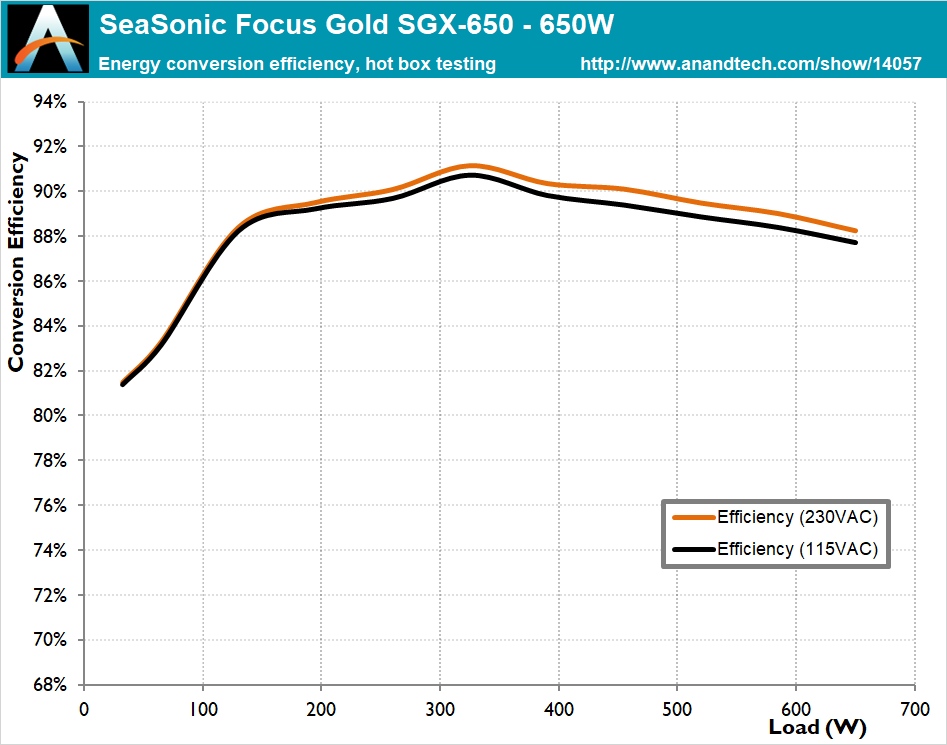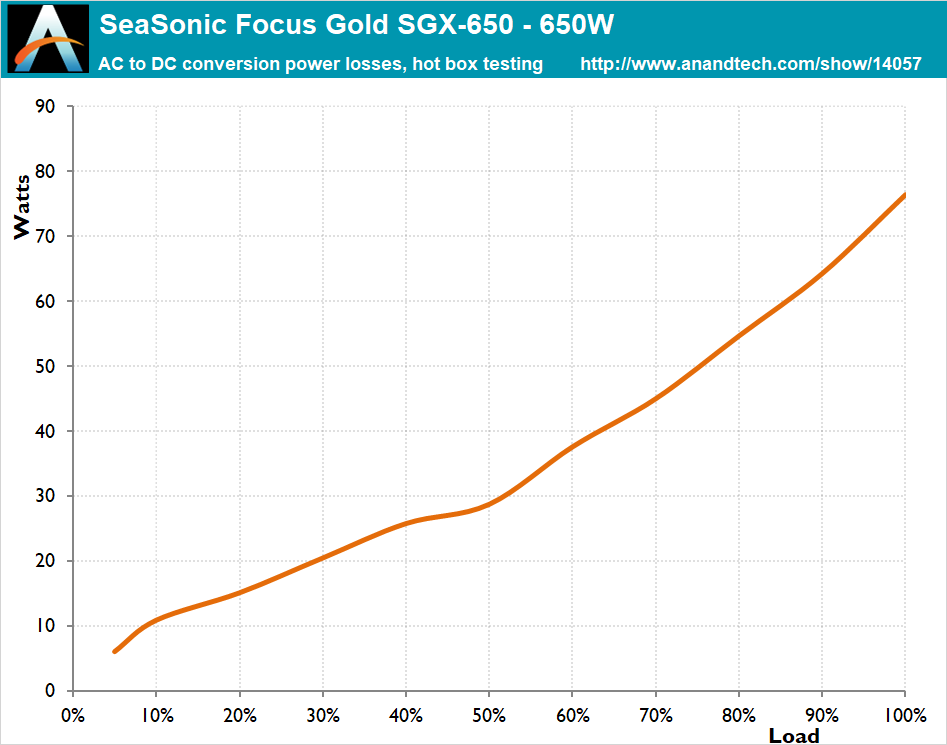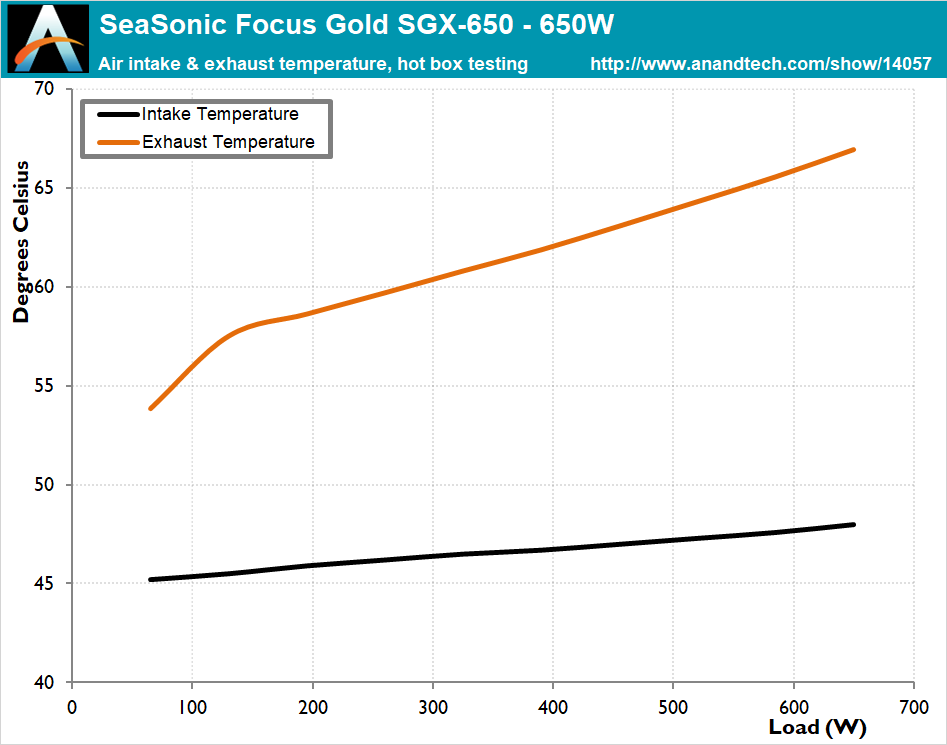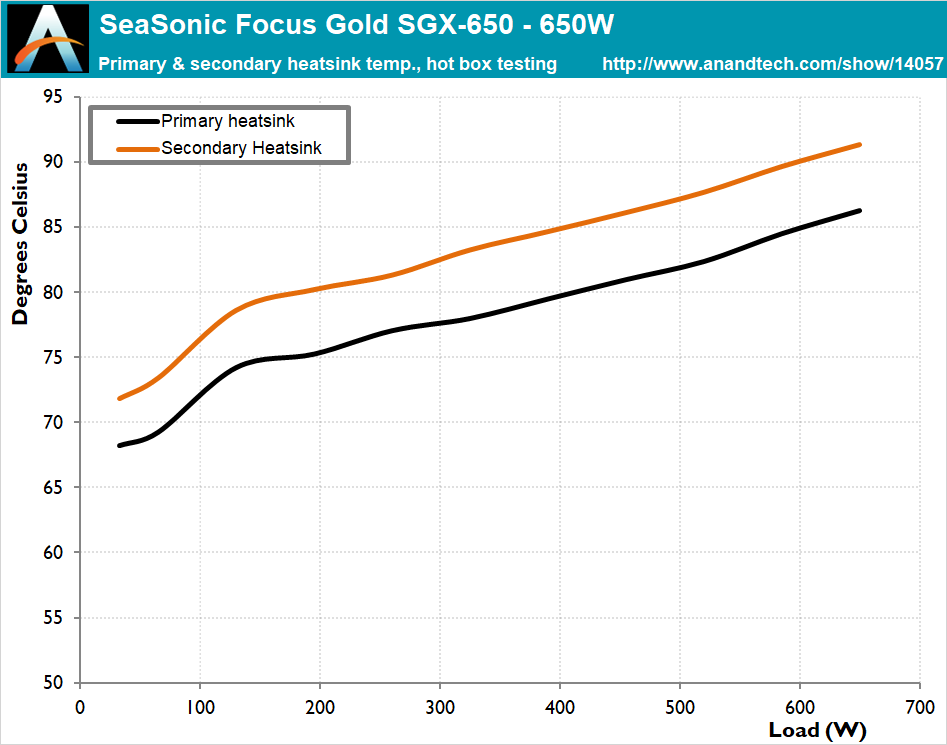The SeaSonic Focus Gold SGX-650 SFX Power Supply Review: Seasonic Starts off SFX With a Stunner
by E. Fylladitakis on March 7, 2019 8:30 AM EST- Posted in
- Cases/Cooling/PSUs
- Seasonic
- PSUs
- SFX
- Focus Gold SGX
Hot Test Results
Even though they complied with the design power quality guidelines, earlier SFX PSU designs often displayed poor power quality figures. However, more recent models, like the powerful SilverStone SX700-LPT and Corsair’s SF450, were greatly improved. The SeaSonic Focus Gold SGX-650 also delivers excellent power quality figures, comparable to those of the better ATX PSUs available.
Overall, filtering is very good on all lines. Our instruments recorded a maximum voltage ripple on the 12V line of only 26 mV under maximum load, with equally low voltage ripple figures on the secondary 3.3V and 5V lines. Voltage regulation is equally impressive, with the 12V maintaining a regulation of 1.0% within the nominal load range and even tighter regulation on the secondary lines.
| Main Output | ||||||||
| Load (Watts) | 131,66 W | 328,95 W | 489,82 W | 651,52 W | ||||
| Load (Percent) | 20,26% | 50,61% | 75,36% | 100,23% | ||||
| Amperes | Volts | Amperes | Volts | Amperes | Volts | Amperes | Volts | |
| 3.3 V | 1,78 | 3,38 | 4,45 | 3,38 | 6,67 | 3,35 | 8,89 | 3,34 |
| 5 V | 1,78 | 5,06 | 4,45 | 5,04 | 6,67 | 5,03 | 8,89 | 5,02 |
| 12 V | 9,6 | 12,15 | 24,01 | 12,14 | 36,01 | 12,05 | 48,02 | 12,02 |
| Line | Regulation (20% to 100% load) |
Voltage Ripple (mV) | |||||
| 20% Load | 50% Load | 75% Load | 100% Load | CL1 12V |
CL2 3.3V + 5V |
||
| 3.3V | 0,9% | 8 | 8 | 12 | 12 | 8 | 16 |
| 5V | 0,8% | 10 | 12 | 16 | 18 | 8 | 20 |
| 12V | 1,1% | 12 | 16 | 20 | 26 | 30 | 26 |
Looking at our hotbox test results, although the energy conversion efficiency of the SeaSonic Focus Gold SGX-650 does not drop significantly at first when it's inside the hotbox, there is a significant degradation once the load passes 550 Watts. This suggests that the PSU is finally getting thermally stressed at this point. The average efficiency reduction is 1.1%, with a drop of over 2.5% at 100% load, indicating significant thermal stress.
Meanwhile when it comes to cooling, when placed in our hotbox the fan in the SeaSonic Focus Gold SGX-650 started almost immediately after the PSU was powered-on. Noise levels were initially low but the dB(A) figures start climbing quickly when the load passed 300 Watts, with the PSU relying on the thin 120 mm fan for reliable operation. The fan reached its maximum speed with a 585 Watt load, struggling to maintain operational temperatures inside the PSU. Overall the fan does manage to keep the SeaSonic Focus Gold SGX-650 operational under these harsh operating conditions, if only barely.















38 Comments
View All Comments
Sivar - Thursday, March 7, 2019 - link
I thought I'd report a typo: "Although the selection of **hgih**-end SFX PSUs"Thank you for the article.
Ryan Smith - Thursday, March 7, 2019 - link
Thanks!SonicIce - Thursday, March 7, 2019 - link
There was a short period where their high end PSU's were manufactured in Taiwan with a 12 year warranty. Wonder why they went back to China?Hul8 - Thursday, March 7, 2019 - link
The Focus series is not high end, that's why.Alistair - Thursday, March 7, 2019 - link
It's a review without a comparison to the Corsair model? What kind of review is that...Alistair - Friday, March 8, 2019 - link
That came out more negative than I meant it to. But I mainly want to know what advantages the Seasonic model might have vs. the Corsair one.FXi - Thursday, March 7, 2019 - link
This might make a very nice and quiet PSU for the Alienware amplifierR3MF - Friday, March 8, 2019 - link
"Opting to go with a 1200mm anyhow, SeaSonic has lengthened the chassis slightly, so the Focus Gold SGX-650 measures 25 mm longer than a standard SFX PSU"The missing part that seems pretty crucial for a product review:
"We call this SFX-L", folks. It won't fit in a traditional SFX chassis, but that's fine because it's better. But as responsible reviewers, we thought you should know that."
Your welcome. ;)
PeachNCream - Friday, March 8, 2019 - link
It's a good point, but the manufacturer is pretty clear about it on sites where the PSU in question can be purchased. There are a number of SFF cases that will accept SFX-L power supplies too because its difficult to cram mid- to high-output circuitry into a standard SFX supply. I do agree that it ought to be more clearly noted in the article, but there are other places where a potential buyer will have a chance to discover the size before making a purchase.justareader - Friday, March 8, 2019 - link
The whole article is about SFX with no explanation. SFX is mention over and over and over. Does the author know? Does not matter this is a tech site, acronyms should always be stated complete at least once.